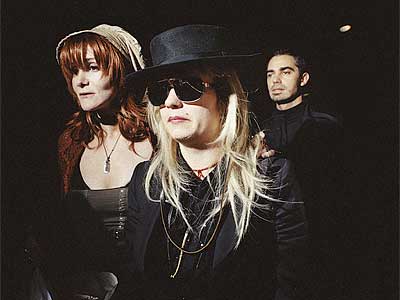 |
Laura Albert (a.k.a. Speedie or Emily Frasier), left, with JT LeRoy at an event he hosted at Deitch Projects last year.
(Photo: Danielle Levitt) |
In 2000, when JT LeRoy’s novel Sarah was published, I attended his first reading in San Francisco, where local writers read in place of the pathologically shy author. Beforehand, Mark Ewert, who had helped organize the reading, shared rumors with me about LeRoy. Because almost no one had ever met him in person, some people thought novelist Dennis Cooper was actually the author, or maybe Ewert himself, Cooper’s ex-boyfriend. Certainly LeRoy seemed suspiciously similar to the characters in Cooper’s novels, fucked-up teenage boys in perpetual danger, or to the wise, otherworldly children in Ewert’s Web film Piki & Poko.
JT, or Jeremy, LeRoy, or “Terminator” (as he was first known), was a teenage hustler who’d been pimped out as a cross-dressed prostitute by his mother at truck stops throughout the South, until he landed on the streets of San Francisco in the early-to-mid-nineties. At the time, Ewert himself was sure that LeRoy was more or less whom he claimed to be; he’d spent hours on the phone with LeRoy. He even spotted someone at the reading whom he believed to be JT, appearing incognito. Ewert reported his hunch to Dennis Cooper, who reported it to JT. Ewert had spotted him, JT confessed, and JT was highly upset.
The JT legend incorporated this anonymous, spectral presence into its mythology. Even if JT didn’t show his face, we could still assume that anytime he had an event—and there were many—he was there, somewhere; we just couldn’t see him. According to the official story, available in dozens of interviews LeRoy has conducted almost entirely by phone or e-mail, LeRoy was saved from his street life at the age of 13 or 14 by psychologist Dr. Terrence Owens. To give JT continuity between therapy sessions, Owens suggested that JT write down his stories, which Owens then gave to his neighbor, the editor Eric Wilinski, for feedback. JT contacted Wilinski and, through him, JT’s favorite poet, Sharon Olds. A john who liked to read Olds’s work while having sex with JT had given him her books, JT once said—and Olds happened to have run the graduate program Wilinski attended. A later addition to JT’s story has LeRoy found on the streets by Emily Frasier, an outreach worker who recommended him to Owens around 1993, when he was 13, and who lived with him in an intimate alternate family, along with her husband and their child.
Around the same time, JT also reached out to other literary figures by fax: In 1994, he got in touch with Dennis Cooper by faxing a request through Cooper’s agent, Ira Silverberg. He struck up a telephone friendship with Cooper, who introduced him to the writer Bruce Benderson, through whom he contacted novelist Joel Rose, writer Laurie Stone, editor Karen Rinaldi, and agent Henry Dunow. By the age of 16, he was being published in Nerve, the New York Press, Spin, and various anthologies, and by 17, he had a book deal, brokered by Rinaldi and Dunow, at Crown. That novel, Sarah, was followed by a collection of stories in 2001 that was recently made into a film by Asia Argento. Still just in his twenties, JT had been translated into twenty languages, was making movie deals, and was writing the lyrics for a band, Thistle.
After the 2000 reading, I began to collect other pieces of the story. Ewert, Cooper, and Benderson had never seen him in person, and neither had his agent nor his editors. (When we spoke in May, Eric Wilinski did not mention having met JT before 2001, but during final edits of this article, he said he had met him earlier.) According to Dunow, he and Rinaldi discussed the idea of bringing JT to New York to meet other editors at Crown, but JT reacted to the idea with such anxiety that it became clear it was never going to happen. On a trip to San Francisco, Dunow arranged to meet JT in Washington Square Park, but JT didn’t show up. Another editor, Panio Gianopoulos, worked with JT for years; in 2002, they met for the first time in San Francisco—on a street corner, through a car window. JT wore a wig, and his friend Emily did most of the talking.
We can never know for sure who’s on the other end of a screen name or a phone line, and given that these were JT’s two chosen media, the possibilities of his identity seemed endless. I didn’t believe that he was either Ewert or Cooper, although it seemed reasonable that he wasn’t exactly whom he claimed to be either. I spoke to the writer Brian Pera, who’d traveled the country on his own book tour in 2000. Everywhere he went, he’d met other writers who were in contact with JT by e-mail and phone; JT had bonded via extensive, often contradictory revelations, but was never able to meet these carefully cultivated confidants in public or in private.